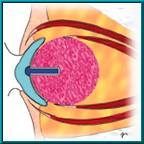The Importance of Implant Size
The Importance of Implant Size

Figure 1. Vascularized Bio-eye with peg
From an ocularist’s perspective, nothing is more important to the end result of the prosthesis fitting than the selection of implant size by the ophthalmologist at the time of surgery. A socket with inadequate room to fit a normal-thickness prosthesis can severely limit the ocularist’s options. A thickness of 6 mm must be available to allow a normal anterior chamber and to accommodate a ball-and-socket motility peg (Fig. 1).
Shell prostheses, resulting from an oversized implant, require direct attachment of the motility peg to the posterior of the eye. This form of direct attachment makes patient insertion of the peg into the implant very difficult since a clear view of the hole is blocked by the prosthesis during insertion. Further, if too much pressure is placed on the suture line due to an oversized implant, implant exposure is much more likely.

Figure 2. Sizing Spheres
One excellent method for determining proper implant size is to use implant sizers at the time of surgery (Fig. 2). Sizers have handles for easy insertion into the orbit and allow assessment of available tissue at the time of closure. A selection of implant sizes should be kept available: at least two sizes should be ready for use (Fig. 3). If a scleral wrapping is used over the implant, the diameter of the implant will be increased by at least 1.5 mm. If your hospital limits the selection of implant sizes available to you, then it is best to ensure that 18-mm or 20-mm diameter implants are available. Currently, the Bio-eye is available in sizes ranging from 16mm to 24mm.

Figure 3. Example of various sizes of Bio-eye implant.
Your ocularist cannot provide you with the results you want and what your patients expect if you fail to give him the space he needs.
Teamwork is the key to success
In order to achieve the best results in any endeavor, cooperation is usually the key to success. Whether it is booking surgery, or making a loan on a house, it takes coordination and cooperation between all interested parties to achieve the desired result. The ophthalmologist-ocularist working relationship is no less important for ultimate success. The ophthalmologist needs to have confidence in his ocularist if the referral is to be made without hesitation. It is the responsibility of the ophthalmologist to know the capabilities of the ocularist and to adequately represent the possibilities to the patient.
Regular phone contacts or meetings with the ocularist to discuss the patient’s requirements are a must for the best results. The ophthalmologist should be open to suggestions from the ocularist as to ways to provide the best possible prosthetic fit. Likewise, the ocularist should be informed as to the ophthalmologist’s needs and expectations. Such teamwork requires regular communication about the overall fitting objectives and needs of each member of the team.

